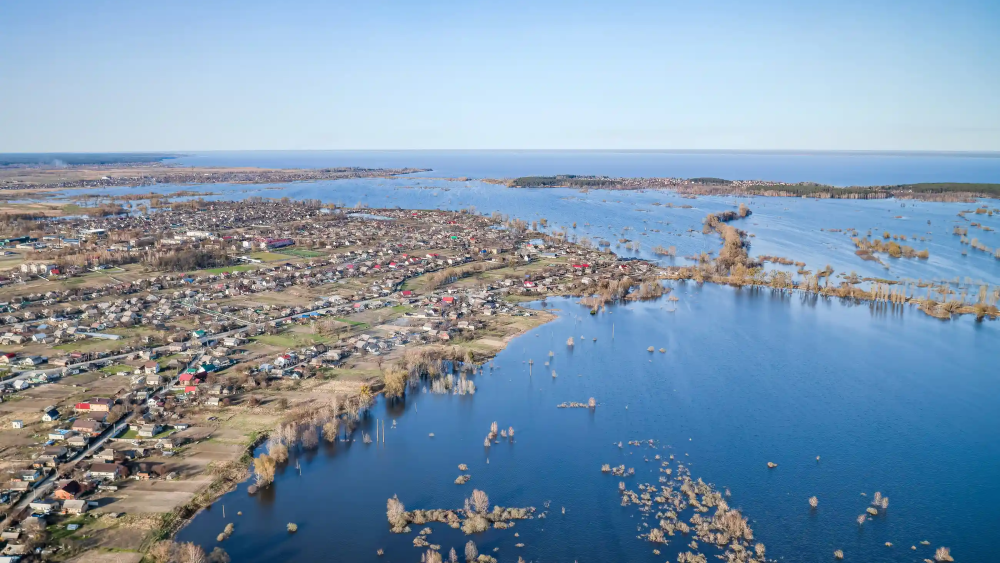
The damaged Irpin dam and the flooded landscape around the village of Demydiv located north to Kyiv, in late February 2022. | Photo: Vincent Mundy
In armed conflicts, freshwater and water infrastructure are among the most vulnerable resources. In this context, access to water resources may trigger the conflict, it may be used as a military weapon, or the water sector itself may be directly affected by acts of war. The number of such incidents has increased significantly in the last decade.
“In Ukraine, military operations are taking place in a region with a highly developed and industrialised water sector. This makes the current armed conflict, and the scale of its impact, unique compared to other current or previously reported water violence around the world”, stated IGB researcher Oleksandra Shumilova, first author of the study, who is herself from Ukraine. Ukraine’s extensive critical water infrastructure includes large multi-purpose reservoirs, hydropower plants, cooling ponds for nuclear power stations, water reservoirs for industry and mining, and an extensive network of water distribution systems for agricultural and municipal purposes.
The international team that conducted the study – involving researchers from Ukraine, Germany, Belgium and the United States – collected and analysed information on the number, location, type and implications of the reported impacts of military operations on the water sector during the first three months of the conflict. The researchers cross-checked data from governmental and media sources of Ukrainian, Russian and international origin available in the period from mid-February to mid-September 2022. The results show a wide range of damage, including flooding of large areas due to dam breaches, pollution from untreated waste water spills, dumped ammunition, an increase in mine water levels, and a significant decline in the quantity and quality of water for drinking and agricultural purposes. A number of the incidents, while not resulting in direct damages, have potential impacts. Examples include missile flights over reservoir dams and cooling systems of nuclear power plants.
Millions face scarcity of drinking water supplies
Ever since the conflict began, hostilities have affected the supply of drinking water to millions of civilians, and the number of people affected is continuing to grow. As the study shows, these shortages are not only due to direct attacks on water pipelines, channels, pumping stations and water treatment plants, but also because of the water infrastructure’s heavy reliance on power supplies, which were also disrupted or collapsed altogether.
“In my home city of Mykolayiv, home to half a million of residents before the war, water is in the news almost every day. A 90-kilometre pipeline that transported water from the Dnieper River was damaged in April 2022. There was no tap water for more than a month. Later, water was supplied from an alternative source, with frequent interruptions, but even after treatment it is not safe to drink. Every day, you see long queues of people with plastic bottles, waiting for water”, remarked Oleksandra Shumilova. According to a recent UN report, the number of people in need of access to safe water across Ukraine increased from 6 to 16 million between April and December 2022. This has a negative impact on health, and increases the risk of epidemic outbreaks in the country.
Military operations cause severe pollution
Military operations cause severe pollution of freshwater resources, not only directly – due to military ammunition and war equipment being dumped, for example – but also indirectly, such as from damage to industrial facilities. By early June 2022, more than 25 major Ukrainian industrial enterprises had been damaged or completely destroyed. The most prominent examples were AZOT, a producer of ammonia, Avdievka Coke and Chemical Plant, and Azovstal Iron and Steel Works in Mariupol.
Most of the water infrastructure is located in the southern and eastern parts of the country, areas with intensive agricultural production and large industrial plants for metal processing, mining and chemical production. "These regions are particularly vulnerable in this war, highlighting the importance of protecting water systems from contamination and violence”, explained Peter Gleick, co-founder and Senior Fellow of the Pacific Institute for Studies in Development, Environment, and Security in Oakland, USA. Gleick is one of the authors of the study, and also coordinates the institute’s public database “The Water Conflict Chronology”.
Severe pollution also threatens Europe’s largest agricultural irrigation system
The south of Ukraine, the much-cited breadbasket of Europe, is also home to the Kakhovka Reservoir, which provides water for irrigation system for large-scale agricultural production. It supports the largest system of irrigation canals in Europe, with a total length of more than 1,600 kilometers. This widely branched network of irrigation canals has also become a burial ground for military objects. The decay of war equipment and the decomposition of ammunition under water can result in the release of heavy metals and toxic explosive compounds, which may impact the environment for decades to come.
Flooded mines contaminate drinking water sources and surface waters
The east of the country is home to large industrial plants for metal processing, mining and chemical production, which have been also affected. The rising level of polluted mine waters poses a particular risk in that part of Ukraine. The Donbas region, with a coal basin area 13 times the size of the Ruhr coal basin in Germany, has an extensive network of 220 subsurface mines. Although many mines ceased operations in recent decades, the mine waters still have to be constantly pumped so that they do not rise and overflow to geologically connected mines. Several power outages and direct damage have brought this process to a halt. In the first three months of the conflict alone, six mines were flooded completely and two temporarily. Mine waters with high concentrations of sulphates, chlorides, and heavy metals can then discharge into groundwater and surface waters.
The state of reservoirs on the Dnieper River poses great risks, such as the release of radioactive material
Another cause for concern is the structural damage that potentially can be caused by attacks to large reservoirs along the Dnieper River. These reservoirs are important not only for agriculture, but also for generating power and cooling nuclear power plants. A dam failure on the Dnieper also poses the risk of secondary radioactive contamination from the uncontrolled release of radioactive material accumulated in the sediments following the 1986 Chernobyl disaster, when the reservoirs of the Dnieper cascade acted as sinks for radioactive caesium. The Zaporizhzhia NPP, the largest nuclear power plant in Europe, is located on the banks of the Kakhovka Reservoir. Its water is needed for the reactor’s cooling system. A breach of the dam there would therefore endanger the safety of the nuclear power plant.
Previous disasters indicate potential scale of some of the impacts
At present, there can be no full assessment of the impact on freshwater resources, due to restricted access to the affected areas and possible discrepancies in the available reports. In addition, there are many transboundary water catchment areas – and pollutants released into the environment can spread over long distances. Ninety-eight per cent of the catchment area of Ukrainian rivers flows into the Black Sea and the Sea of Azov, with the remaining two per cent flowing into the Baltic Sea. There are historical analogies to some of the incidents, examples being the catastrophic flood that occurred following damage to the Dnieper Hydroelectric Station in World War II, and the spread of radionuclides through water as a result of the Chernobyl disaster.
Action must be taken now to ensure restoration
“Our study highlights just a few examples of damage and potential long-term and far-reaching consequences of this war. The catchment areas of freshwater ecosystems are transboundary, and the international community, including scientists, should take urgent action now to restore the water sector in Ukraine,” asserted Klement Tockner, one of the authors of the study, and Director General of SGN.
The scientific article highlights avenues for future research. For example, spatial mathematical and cartographic modelling using remote sensing data could be applied to simulate flooding after dam breaches, estimate the spread of pollutants or rise in level of underground mine waters, and to assess the quality of water for drinking and irrigation purposes.
Read the article in Nature Sustainability >
The sources and references used in the study:
As their primary source of information, the researchers used weekly reports by the Ukrainian Ministry of Ecology and Natural Resources, reports by the Ministry of Reintegration of Temporarily Occupied Territories and Internally Displaced Persons of Ukraine, and reports by Ukrainian regional war administrations. To search for information from media sources, they used keywords related to the reported impacts in Ukrainian, Russian and English in Google search. In the majority of incidents (64 in total), most of the information came from official Ukrainian government and media sources (43 and 56, respectively), with additional information found in sources of international or Russian origin (28 and 24, respectively). All references and sources are listed in the source file of the publication.
Interesting background information on the topic:
Public database on the chronology of water conflicts
The open-source database “The Water Conflict Chronology” offered by the Californian Pacific Institute in Oakland contains accounts of violence related to freshwater resources and water infrastructure from 2500 BC to the present. The database currently contains more than 1,300 entries covering three different categories:
1. Water as a “trigger” of conflict, i.e. control over or access to water leads to violence.
2. Water as a “weapon”, i.e. water is used as a weapon or leverage during a conflict.
3. Water as a “casualty” of violence, i.e. water systems are directly attacked.
In the past decade, the number of recorded conflicts has increased significantly, especially when water was the trigger and/or casualty of a conflict. In addition to these categories, water resources are often at risk of collateral damage (e.g. contamination caused by military operations). The Water Conflict Chronology >






